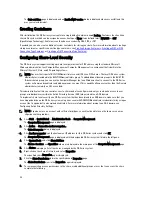
3.
In Container Name, type the name of the container.
Container names cannot exceed 32 characters in length, and can be composed of any combination of the following
characters:
NOTE: The DR Series system does not support the use of the following special characters in container
names: /, #, or @.
– A-Z (uppercase letters)
– a-z (lowercase letters)
– 0-9 (numbers)
– dash (-) or underscore (_) special characters
4.
In Marker Type, select from the following choices: None, Auto, CommVault, Networker, TSM, or ARCserve.
If you select the Auto marker type, this will enable all marker types to be detected. As a best practice, if you have
only one type of DMA with traffic directed to a container, it is best to select the corresponding marker type (for
example, CommVault). Conversely, as a best practice, if you have traffic from a DMA that is not one of the
supported marker types, it is best to disable marker detection for the container by selecting the None marker type.
5.
In Connection Type, select NFS/CIFS.
This displays the following in the NFS and CIFS panes:
– NFS access path: <
system name
>/containers/<
container name
>
– CIFS share path: <
system name
>\<
container name
>
NOTE: To create an NFS connection type, skip to step 6. To create a CIFS connection type, skip to step 10.
6.
To select an NFS connection type, click Enable NFS in the NFS pane.
The Client Access, NFS Options, and Map root to panes are displayed, and is where you configure this container to
use NFS to backup Unix or Linux clients.
7.
In the Client Access pane, define a specific NFS client (or all clients) that can access the NFS container or manage
clients who can access this container:
– To allow open access for all clients to the NFS container you create, select Open Access (all clients have
access). When you select this setting, this action removes the Add client (IP or FQDN Hostname) and
Clients text boxes. Select this check box
only
if you want to enable access for all clients to this NFS
container.
– To define a specific client that can access the NFS container you create, type the IP address (or its FQDN
hostname) in the Add clients (IP or FQDN Hostname) text box, and click Add. The “added” client appears in
the Clients list box.
– To delete an existing client from the NFS Clients list box, select the IP address (or FQDN hostname) of the
client you want to delete, and click Remove. The “deleted” client disappears from the list box.
8.
In the NFS Options pane, define which NFS options to use for the client, by selecting from the NFS Options choices:
rw (allows read-write access), ro (allows read-only access), or insecure (allows for replies being made to requests
before the changes in the request are committed to disk).
NOTE: The DR Series system always commits writes to NVRAM first before committing any changes to disk.
9.
In the Map root to pane, select the user level you want mapped to this container from one of the following options
from the drop-down list:
– nobody represents a user on the system without root access permissions
– root represents a remote user with root access to read, write, and access files on the system
– administrator represents the system administrator
88
Содержание PowerVault DX6112
Страница 1: ...Dell DR Series System Administrator Guide ...
Страница 32: ...32 ...
Страница 70: ...70 ...
Страница 86: ...86 ...
Страница 100: ...For more information on Replication schedules see Creating a Replication Schedule 100 ...
Страница 114: ...114 ...
















































